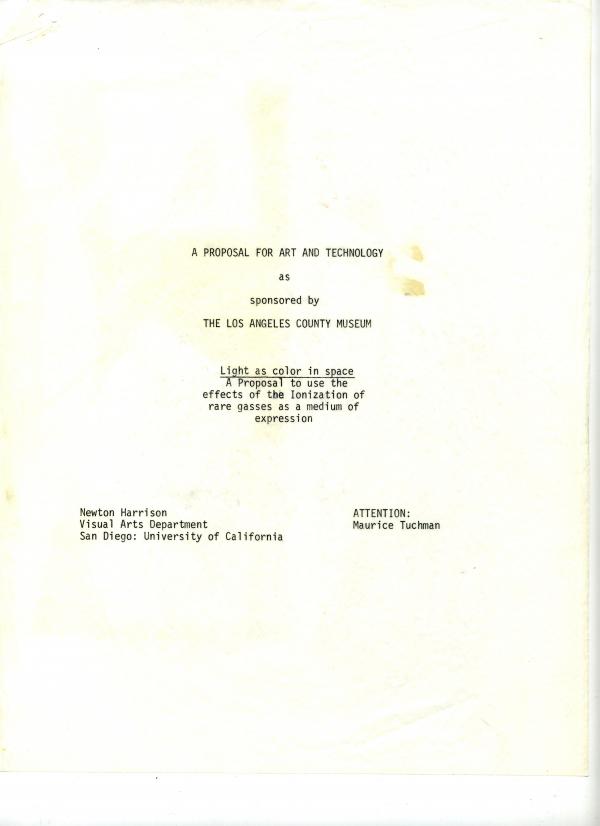Throughout the development of the new Art + Technology Lab at LACMA, the museum’s archives played an important role in providing staff, researchers, and others with a glimpse into the motivations, processes, successes, and (perhaps most interestingly) the failures of the Art and Technology program that originally ran from 1967–71. The Modern Art Department Art and Technology records, housed in the Balch Research Library, are the only curatorial records from that program that we know still exist at LACMA. They are the museum’s most frequently requested archival records, comprising original documentation in a variety of forms, including correspondence, memos, interview transcripts, drawings, photographs, and drafts of publications. These materials serve as a unique and valuable resource for understanding the context of this significant event directly through the voice of the curators, artists, and others who shaped and participated in the program.
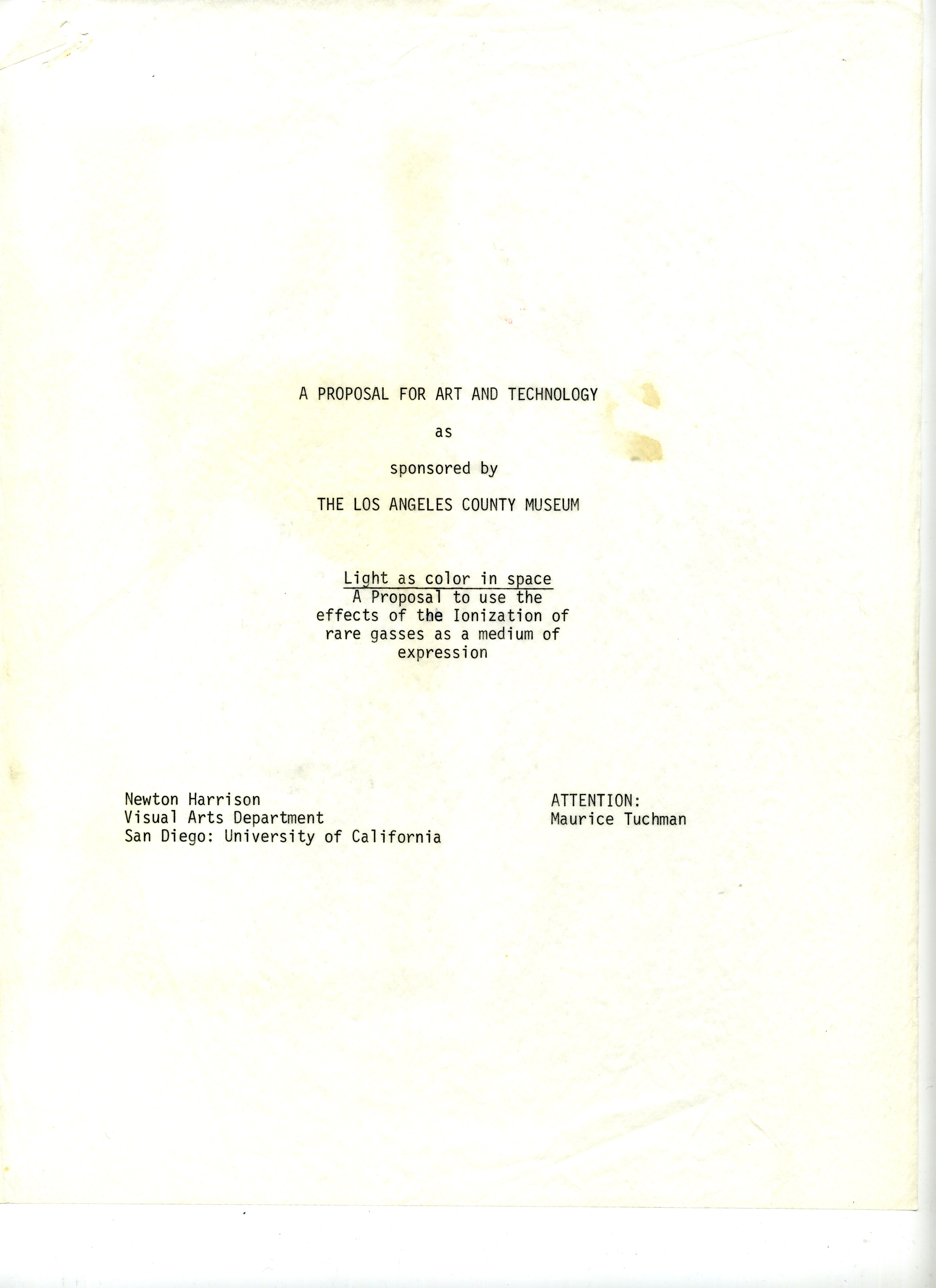 A Proposal for Art and Technology as sponsored by the Los Angeles County Museum, by Newton Harrison, undated, Modern Art Department Art and Technology Records, LACMA Balch Art Research Library, MOD.001.001. Click to view full-sized image.
A Proposal for Art and Technology as sponsored by the Los Angeles County Museum, by Newton Harrison, undated, Modern Art Department Art and Technology Records, LACMA Balch Art Research Library, MOD.001.001. Click to view full-sized image.
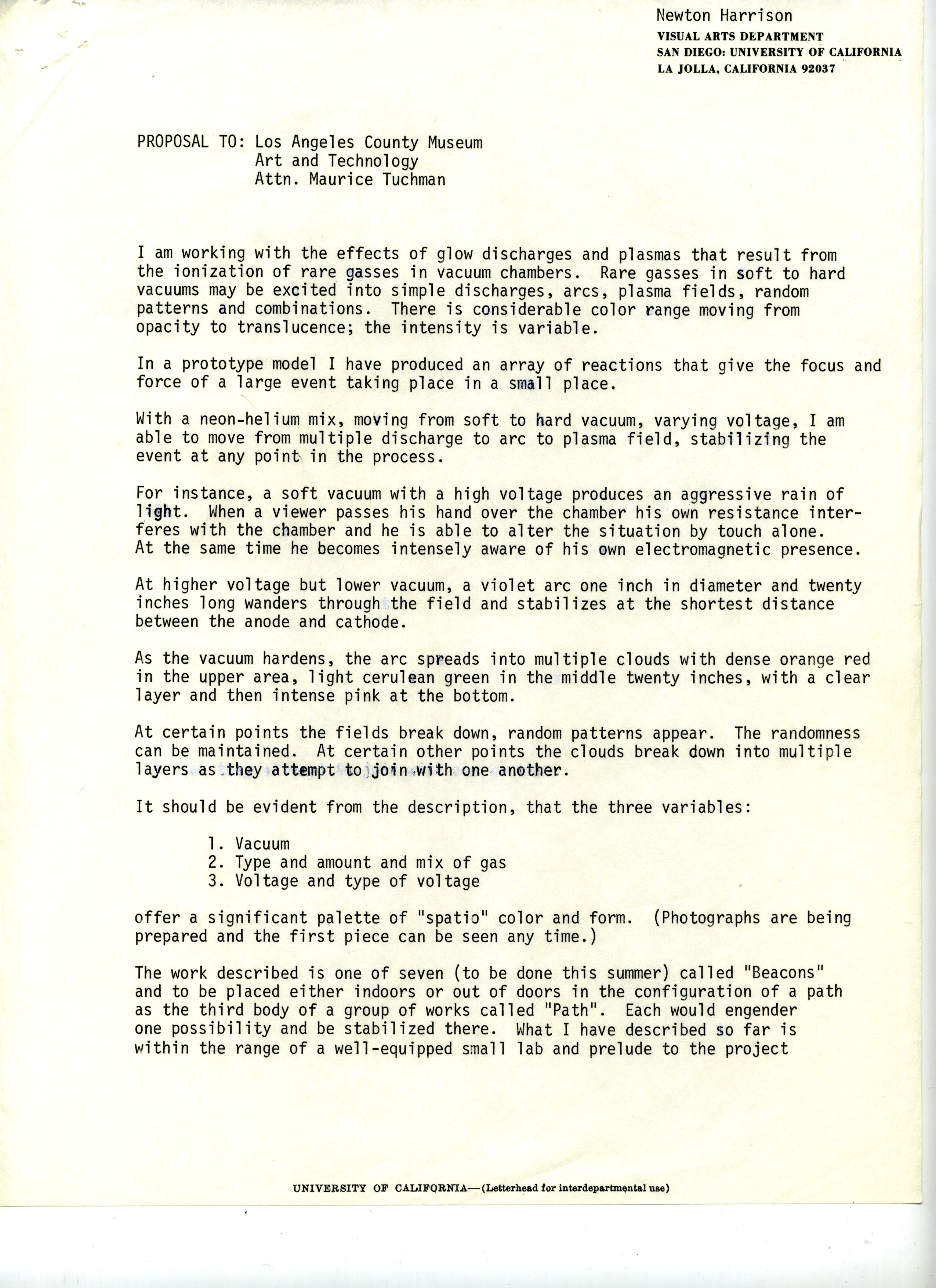 A Proposal for Art and Technology as sponsored by the Los Angeles County Museum, by Newton Harrison, undated, Modern Art Department Art and Technology Records, LACMA Balch Art Research Library, MOD.001.001. Click to view full-sized image.
A Proposal for Art and Technology as sponsored by the Los Angeles County Museum, by Newton Harrison, undated, Modern Art Department Art and Technology Records, LACMA Balch Art Research Library, MOD.001.001. Click to view full-sized image.
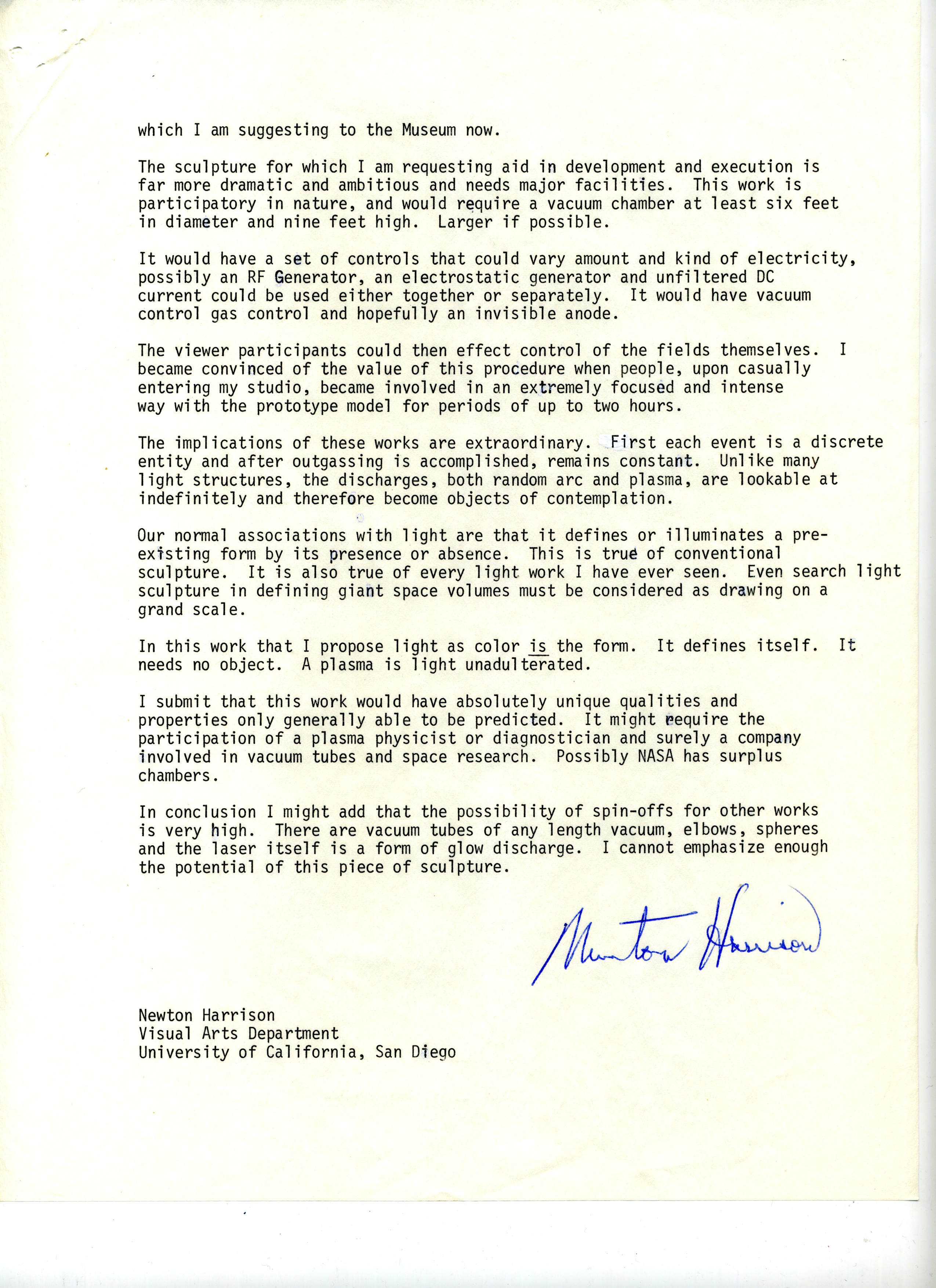 A Proposal for Art and Technology as sponsored by the Los Angeles County Museum, by Newton Harrison, undated, Modern Art Department Art and Technology Records, LACMA Balch Art Research Library, MOD.001.001. Click to view full-sized image.
A Proposal for Art and Technology as sponsored by the Los Angeles County Museum, by Newton Harrison, undated, Modern Art Department Art and Technology Records, LACMA Balch Art Research Library, MOD.001.001. Click to view full-sized image.
As important as these records have proven to be, the collection fills only six small boxes and would barely fill a file drawer. In addition, of the 75 artists that appear in the publication A Report on the Art and Technology Program of the Los Angeles County Museum of Art, 1967–1971, only 29 are represented in the actual records. Of the over 20 corporations mentioned in the report, only one is represented in the records. The absence of primary documents on participating artists and corporations is unfortunate enough, but completely missing is the evidence of projects proposed and rejected, the corporations and artists approached that did not participate, and the reasons for why these things occurred. The resulting reality of such fragmentary documentation is that our understanding can only be partial at best.
 Letter of support written on behalf of James Lee Byars by Sam Wagstaff dated May 13,1971, Modern Art Department Art and Technology Records, LACMA Balch Art Research Library, MOD.001.001. Click to view full-sized image.
Letter of support written on behalf of James Lee Byars by Sam Wagstaff dated May 13,1971, Modern Art Department Art and Technology Records, LACMA Balch Art Research Library, MOD.001.001. Click to view full-sized image.
These gaps suggest that many more letters, memos, notes, and other materials must have been created and had once existed—but the nature of those records or what may have happened to them is anyone’s guess. So how does something so important go missing?
As with many museums, LACMA has spent most of its history without a plan or person to manage its historic records. Busy museum staff packed up boxes of files and put them wherever they could in order to clear the decks for their next important project. When staff turned over, there was no one to remember what was stored and what was discarded. There was no one in particular to keep an eye on storage areas to make sure they were clean and dry and that the records stored there were safe (or to know exactly what was lost if something went wrong). LACMA did not start exercising firm control over its records until 2010, 45 years after its grand opening. That’s 45 years of boxes of records accumulating, gathering dust and mystery.
But LACMA’s in good company. Some museums of similar scope and size to LACMA, the Cleveland Museum of Art, the Museum of Fine Arts Houston, and the Philadelphia Museum of Art, have had archives departments since 1989, 1984, and 1976, respectively. That’s 76, 84, and 100 years between the time these museum's were established and when they began to bring order to their historic records and making them usable for research. With just 45 years as an independent encyclopedic museum behind LACMA before establishing its archives, the museum was and is in great shape to get its surviving records organized and to start the systematic collection of today’s records to help provide a more complete picture of LACMA’s activities for future generations of researchers.
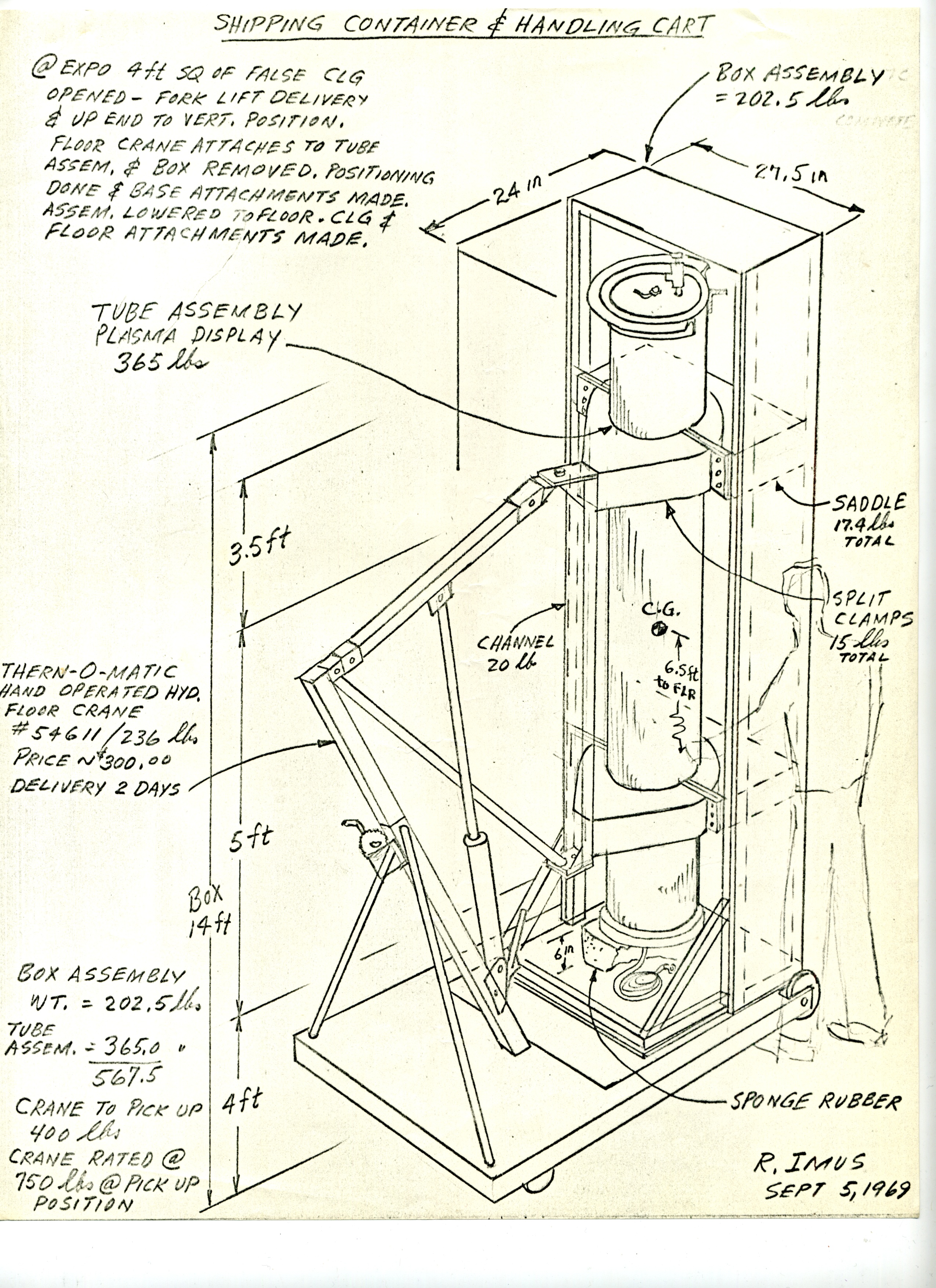 Drawing of shipping container and handling cart made for shipping the gas plasma tubes for Newton Harrison's Art and Technology piece to Osaka, Japan, for Expo '70, dated September 5, 1969, Modern Art Department Art and Technology Records, LACMA Balch Art Research Library, MOD.001.001. Click to view full-sized image.
Drawing of shipping container and handling cart made for shipping the gas plasma tubes for Newton Harrison's Art and Technology piece to Osaka, Japan, for Expo '70, dated September 5, 1969, Modern Art Department Art and Technology Records, LACMA Balch Art Research Library, MOD.001.001. Click to view full-sized image.
With the establishment of an institutional archives, LACMA is now in a position to better preserve and provide access to important records such as those produced by the Art and Technology program. Records are inventoried and given proper housing, as well as storage in locations that can be tracked. Searchable finding aids, inventorying, and providing background on fully processed collections are available on lacma.org and the Online Archive of California, making them discoverable by researchers worldwide.
With LACMA’s 50th anniversary approaching next year, the archival records serve as evidence of what the museum has accomplished and what it has become over the last half century, but it is not complete, as the gaps in the Art and Technology records show. Responsibly caring for the museum’s history through records management and the institutional archives will preserve what we still have of our historic records and help to create a more complete picture of the cultural, scholarly, and educational activities at LACMA now and for the next 50 years.
Julia Kim, Stacks Manager
Jessica Gambling, Archivist
Courtney Dean, Archives Program Specialist



